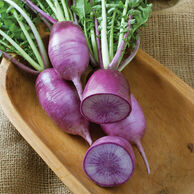Written by Chris McLaughlin

Daikon is an easy, fast growing crop.
Around the globe, daikon radishes are called winter radish, Japanese radish, Chinese radish, luobo, and mooli. Compared to their red radish cousins brought to America from Europe, they are bigger and can be less peppery. While daikon deliver the radish spice we love, many varieties also offer sweeter flavor than the typical salad radish, which calms the bite a bit.

Colorful varieties add to the fun of growing daikon / photo credit Johnny’s Selected Seeds.
Did we mention they’re easy to grow? Let’s get started!
Resembling a chunky carrot, daikon may be cylindrical, round, or tapered. Yes, some daikon are a foot long or more, but gardeners have many smaller varieties to pick from. Their skin ranges from white or light green to purple, yellow, pink, or red. Inside, daikon flesh is almost always white, with a few exceptions.
Any way you use carrots, you can use daikon. These versatile root vegetables can be eaten raw, pickled, stir-fried, steamed, baked, boiled or grated into salads, soups, and stews. If you’re a kimchi fan, growing ‘Alpine’ daikon is a must. Valued as one of the most nutritionally loaded foods, daikon are also one of the lowest in calories.
Here’s more daikon superpowers: they’re a great source of fiber, Vitamin C, and calcium and have been touted to reduce inflammation, improve digestion and respiratory health.
Daikon Loves Cool Weather
These fast-growing annuals are appropriate for gardens in USDA zones 2-11. Although a few varieties tolerate summer heat, most prefer cooler weather. Plant seeds in the late summer or early fall for an autumn harvest, early spring under a hoop for a late spring crop.

Use a top hat to make your soil deeper.
How many per square? That depends how large the variety. Read the “thin to” inches on the packet of seeds; if that type needs 3 inches between plants, for example, plant 9 to a square. Growing a bigger variety? Plant 4 per square. For long daikon varieties, add a “top hat” filled with Mel’s Mix to your square. Or, try the deep bucket method and keep the daikon out of your regular SFG.
Radishes need moisture; do not let your Mel’s Mix dry out. Moist, not wet, is the goal.
When plant leaves reach about eight inches long, you’ll see the shoulders of daikon pushing above the soil. They’re ready to harvest!
Wrap you hand around the entire top of the leaves (where the leaves meet the root) and give it a steady pull. If the first one you harvest isn’t as large as you expected, you can leave the rest to grow a bit larger as long as you pull them up before the first hard frost. Freezing temperatures will rot the radish.
Daikon Varieties

If you love kimchi, be sure to plant ‘Alpine’ daikon.
The following are a few of the many shorter daikon varieties that pair up nicely with your Square Foot Garden.
- ‘Shunkyo Semi-Long’ – 4”-5” cylindrical/red skin with white flesh/hot & sweet flavor/35 days.
- ‘Alpine’ – 4”-6” cylindrical/white skin with green shoulders and white flesh/mild, sweet, peppery flavor/55 days.
- ‘Watermelon Radish’ (‘Chinese Red Meat’ or ‘Roseheart’) – 2”-4” round/pale green-white skin with pink flesh/sweet and subtly spicy flavor/50 days.
- ‘K-N Bravo’ — 4’-6’ cylindrical/purple skin with light purple or purple straked flesh/sweet flavor/49 days.
- ‘Mini Mak’ — 4”-5” cylindrical/white skin and flesh/sweet and mildly spicy flavor/50 days.



